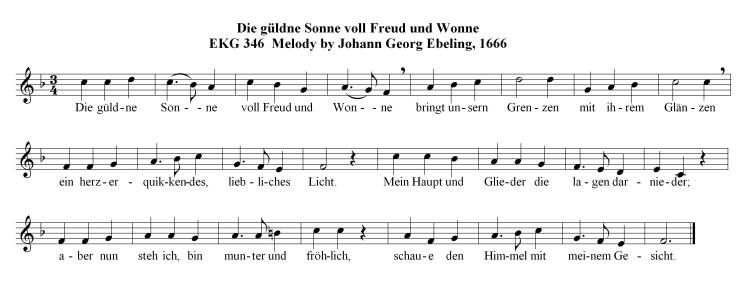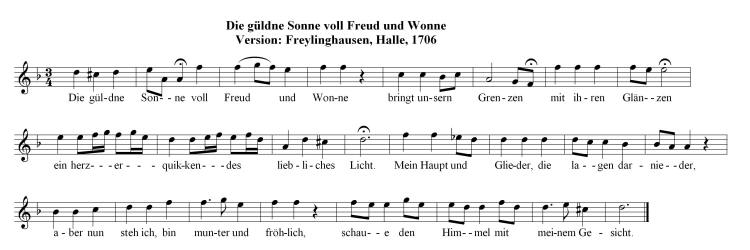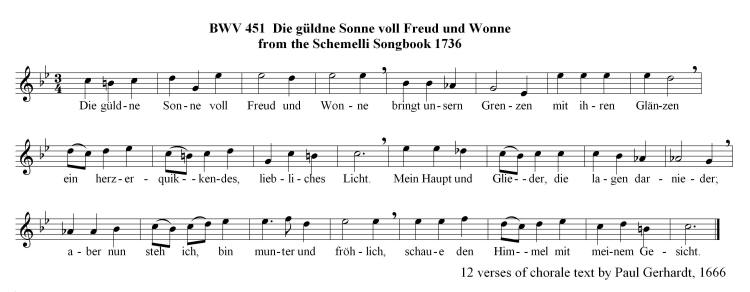|
Chorale Melodies used in Bach's Vocal Works
Die güldne Sonne voll Freud und Wonne
|
|
Melody & Text | Use of the CM by Bach | Use of the CM by other composers |
| |
|
Melody & Text: Zahn: 8015 | EKG: -- |
|
Text: Die güldne Sonne voll Freud und Wonne |
|
Paul Gerhardt, 1666 - 12 verses. |
| |
|
Melody (Melody 1): |
|
Anonymous, 1708. |
| |
|
Earlier but different melody (Melody 2): EKG: 346 |
|
The earlier original, but different and much more famous melody to the same text:
Composer: Johann Georg Ebeling, 1666; EKG: 346
Von Johann Georg Ebeling in: Pauli Gerhardi Geistliche Andachten, Berlin 1666. |
|

|
|
>>Die Melodie von »Die güldne Sonne voll Freud und Wonne« beruht ganz auf der Tradition der frühbarocken Kanzonette. Die Verwandtschaft dieser Weise mit Gastoldis »An hellen Tagen«, die in den ev. Gemeindegesang in Verbindung mit J. Lindemanns »In dir ist Freude« Eingang gefunden hat, ist unverkennbar. Ebelings Weisen gehen wie die sämtlicher bedeutenden Melodienschöpfer jener Zeit auf intensive Wort-Tonbehandlung aus. Ihre Grenze findet diese jedoch an der offenbaren Bezogenheit auf den Text der jeweils ersten Strophe eines Liedes, wie es sich etwa in der Tonmalerei vom Abgesang der Weise »Die güldene Sonne« zeigt.<<
Author: Walter Blankenburg, MGG1, Bärenreiter, 1986
(„The melody of Die güldne Sonne voll Freud und Wonne is based entirely upon the tradition of the early Baroque canzonetta. The connection of this melody to Gastoldi’s An hellen Tagen which has become a part of Evangelical congregational singing with the help of J. Lindemann’s transformation of the Gastoldi original into In dir ist Freude, is undeniable. Ebeling’s melodies, as is the case also with all the most famous composers of chorale melodies, concentrate on an intensive treatment of and regard for the relationship between the text and the music. The application of such a treatment is limited, to be sure, to only the text of the first verse of a chorale as can be seen in the obvious word-painting in the ‘Abgesang’ of the melody, Die güldne Sonne. [the melody descends stepwise down one octave on the words Mein Haupt und Glieder, die lagen darnieder{“My head and limbs were lying down”} but it ascends upward on aber nun steh ich, bin munter und fröhlich {“but now I am standing again and am full of life and happy”}] |
| |
|
Another different melody (Melody 3): Zahn: 8015 |
|
Johann Anastasius Freylinghausen Halle, 1708 (4th edition of Geistreiches Gesangbuch….) [Note how this (anonymous) version of the melody, 42 years later, emulates the word-painting feature first employed by Ebeling.] |
|

|
| |
|
Use of the Chorale Melody by Bach: |
|
BWV 451 1736 from the Schmelli Songbook [Musicalisches Gesang=Buch….Leipzig, 1736] The modifications to the melody and the added bass line (not figured in this instance!) are probably by Bach. Note the similarities with the melody (Zahn 8015) in the Freylinghausen hymnal with which the Schemelli may have been in competition. |
|
Text: Die güldne Sonne voll Freud und Wonne | EKG: --
Author: Paul Gerhardt (1666) |
|
Ver |
Work |
Mvt. |
Year |
Br |
RE |
KE |
Di |
BC |
Score |
Music Examples |
|
1-12 |
BWV 451 |
- |
1736 |
- |
- |
- |
- |
F219 |
- |
- |
|

|
| |
|
Use of the Chorale Melody by other composers: |
|
Franz Lehrndorfer (b 1928):
Improvisation on Die güldene Sonne for organ (most
probably based upon Ebeling's melody and not
Bach's transformation for BWV 451) |
| |
|
Sources: NBA, vols. III/2.1 & 2.2 in particular [Bärenreiter, 1954 to present] and the BWV ("Bach Werke Verzeichnis") [Breitkopf & Härtel, 1998]
The PDF files of the Chorales were contributed by Margaret Greentree J.S. Bach Chorales
Software: Capella 2004 Software, version 5.1.
Prepared by Thomas Braatz & Aryeh Oron
(June 2006) |